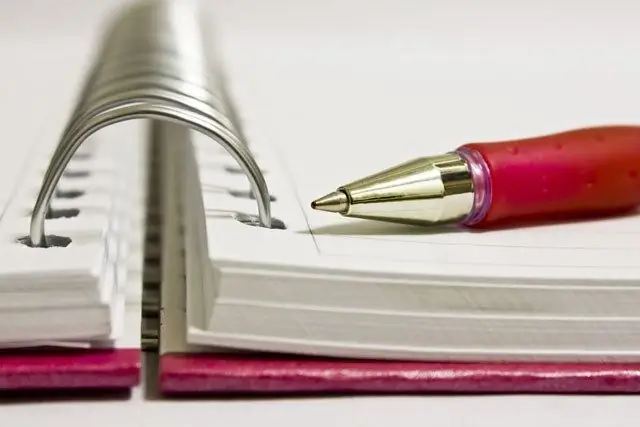- Author Nora Macey [email protected].
- Public 2023-12-16 10:17.
- Last modified 2025-01-23 08:47.
Keeping a careful note can be very helpful in your studies. It doesn't matter if you study at school, university or are engaged in self-education - correctly drawn up notes will be useful in preparing for exams and will become a guide by which you can refresh your knowledge even after several years.

Instructions
Step 1
Choose a notebook that is comfortable for you. If you plan to write not only at the desk, but in the "field" conditions, when you have a free minute, choose a copy with a hard cover. This will help you maintain legible handwriting. In addition, such a notebook will last for a long time, the pages will not fray at the edges and will not wrinkle.
Step 2
Notebooks with inserted blocks of paper are very convenient. You can add missing sheets to them, if suddenly there is more information than you expected. In addition, you can remove unnecessary sheets and leave only the most important in the notebook. Buy several colored plastic spacers with the blocks. On their protruding parts, write the name of the subject, the lectures on which you will record, or any other sign by which the records can be divided into blocks. Place the text vertically.
Step 3
Draw fields in advance on all pages. They are useful not only for school students. On this space, you can take out all the additional information without cluttering the main text.
Step 4
Begin each entry in your notebook with a heading. Write it in a larger font than the rest of the text. Place in the center of the line. Thanks to the headings, you can quickly navigate even in a voluminous notebook.
Step 5
Reduce the key word in each passage. Having written it in its entirety at the beginning of the synopsis, then confine yourself to the first letter with a period. Use other abbreviations to save time. Reduce long words to the following form: first syllable, hyphen, ending. For words that end the same, come up with a shorthand, such as vertical line, wavy line, zigzag. Think about these symbols in advance and write them down separately.
Step 6
You will need the legend to mark the margins. There you can put question marks and exclamation marks so that it is clear which question needs to be clarified or which one to pay special attention to.
Step 7
In order not to get confused in all the invented signs, make up a kind of dictionary. On the last page of the notebook, write down all the symbols and decipher them. Also write down what colors you used to highlight the text. For example, you can underline definitions with a green marker, quotes with red, etc.
Step 8
When recording a lecture, omit all introductory words and constructions. Briefly put out lyrical digressions and references to other sources of information in the fields - write there the author's surname and the title of the book, in which you can read additional information on the topic. Replace complex words with more concise synonyms if this does not change the meaning of the text.
Step 9
When the notebook is finished, write down all the headings in order on the flyleaf. In front of each, write the page on which the entry on this topic begins. Write their numbers on the appropriate pages. It is better to place the number in the upper right corner - the lower corner may fray due to frequent flipping.






